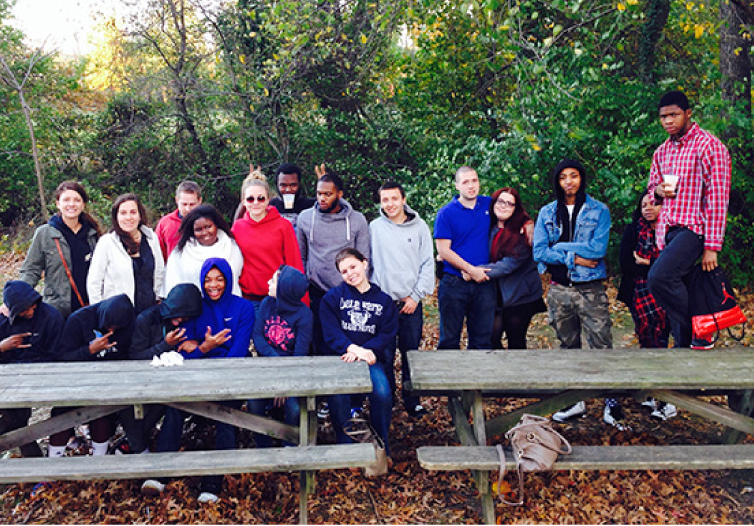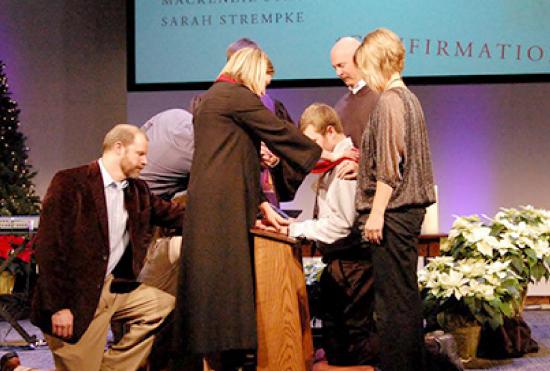



Outreach to people living throughout its area is one way Hope Community Church in Delaware is attracting new guests.
COURTESY PHOTO

Outreach to people living throughout its area is one way Hope Community Church in Delaware is attracting new guests.
COURTESY PHOTO

The Rev. Molly Simpson confirms a new member at Church of the Resurrection-West in Olathe, Kansas.
COURTESY PHOTO
March is Women’s History Month. Since immigrants first brought the Methodist movement to the Americas in the mid-1700s, women have been key to its spread and have played a significant role in developing new churches.
United Methodists recall Barbara Heck, the “mother of American Methodism” and designer of John Street United Methodist Church in New York where congregations have gathered since 1768. In 1850, evangelist and writer Phoebe Palmer was a founder – with the Methodist Ladies’ Home Missionary Society – of the Five Points Mission in a slum area in New York City.
Here, Interpreter highlights two contemporary women church planters.
Hope Community Church, Claymont, Delaware
The Rev. Amy Louise Peters probably never dreamed she would be a church planter.
Raised in the Roman Catholic Church, she graduated from parochial schools. Peters says she became a United Methodist because her husband, Mark, “was willing to go back to church with me if I would attend the church of his youth.” They began attending Hillcrest-Bellefonte United Methodist Church in Wilmington, Delaware., where she found helpful mentors.
“A United Methodist pastor, who counseled us before marriage, took time to explain all the things in common with the Catholic beliefs,” Peters says. “He built that bridge for me long before I ever thought I would cross it.
“Of greatest importance to me, the grace of God touched my heart and soul in that United Methodist church. Every time I attended, I felt peace and acceptance by God that I had never experienced before. Although it was an older congregation, their love and prayers helped me put my past behind me, and I become the new creation in Christ that God had intended for me.”
Then, she explains, “God moved us to Atonement United Methodist Church in Claymont, Delaware.”
Fast forward a few years. A desire “to offer a nontraditional site for worship for persons uncomfortable or withdrawn from a traditional church setting” led Peters to help plant Hope Community Church on the border of Claymont and northern Wilmington.
At the same time, 147-year-old Atonement , Hope’s “mother church,” was experiencing significant growth with its contemporary worship service.
Hope Church opened its doors in September 2013 with about 30 members from Atonement Church. Since then, Hope has had at least 300 people visit. In 2014, weekly worship attendance averaged 50. “It has grown because we never stop trying to get the word out!” Peters says. “Our goal for 2015 is to have 100 worshipers as we celebrate Christmas.”
Church members are “socioeconomically varied but mostly middle and lower class,” she says.
Seed money came from the church development corporation of the Peninsula-Delaware Annual Conference.
Today the Hope and Atonement churches blend study and service as they provide combined young adult, youth and women’s ministries; service projects; discipleship (Life Groups and Bible studies); and a community service day.
Peters has served Atonement for 14 years. As a layperson for the first 10, she was the Christian education director and youth and young adult leader as well as a certified lay speaker. For the past four years, since answering the call to ordained ministry, Peters has been the assistant pastor.
Church planting,” she says, “is like night and day from other types of ministries that I have been involved in. It is so multifaceted, and I am grateful for my many years of experience in different areas of servant leadership that proved invaluable. Church planting is intensely administrative, pastoral and relational. It has stretched me beyond my wildest expectations.”
Peters cherishes her adopted church.
“The United Methodist Church has so much I find appealing,” she says. “John Wesley was a genius, and I am in love with his unique perspective on God’s amazing grace as well as the means of grace for spiritual growth. I especially appreciate the importance of relationship with Christ Jesus and one another, discipleship, evangelism, mission and justice. We have an awesome denomination.
“Every Sunday, I am reduced to tears of joy to see all the new faces at Hope as well as the returning ones that are hungry for hope, thirsty for the word and willing to reach out with the great, good news of Jesus Christ.”
Church of the Resurrection – West Campus, Olathe, Kan.
In autumn 2005, the Rev. Molly Simpson led a team from The United Methodist Church of the Resurrection to launch a “new community of faith” in Olathe, Kansas.
“We started this new church community as a response to the Great Commission and the mission of our church,” Simpson says. “There was a growing part of our city from which people were traveling 25 to 30 minutes to worship at the Leawood campus. We thought that beginning a new church or worshiping community in their neighborhood would not only allow us more effectively to minister to those who were already a part of Resurrection church but also reach out to a new population of people in another part of our city.”
Today, Simpson says, the Olathe church – the West campus – has grown from some 100 interested people to an average of 800 in weekly worship. The members are young families, empty nesters and retirees. Most are middle-income white and multiethnic families.
Church members, she adds, are “passionate about serving their community” through a monthly mission event (“FaithWork”) and quarterly “Mega Mission” days.
Beginning in August 2006, West campus churchgoers first worshipped in a portable classroom at a junior high school before purchasing property. In 2011, they constructed a church building. A capital campaign is under way to fund the second building phase.
“When we started, I was the associate campus pastor,” she says. “The campus pastor and I worked as partners, and we did anything and everything! We invited others to join our launch team, trained leaders, helped shape programs and curriculum, planned worship, went to community events to reach new people, held fellowship events to invite others, planned opportunities to serve our community, taught Bible studies, and recruited and led ministry leaders.
“That’s probably only half of it. Being a church planter demands the bulk of your time in any given week,” says Simpson.
Today Simpson is the Wesley Foundation director at Texas Christian University in Fort Worth, but she has fond memories of church planting.
“While church planting,” Simpson says, “I took for granted how nimble and willing to change we were as individuals and as a system. We were ready to take risks, to try new things, and if they didn't work, we made the changes necessary. In our new faith community, change and adaptation were expected, instead of feared or cause for anxiety.
“In the past two years, I’ve worked with several churches in a coaching role, and I'm very quick to notice the ways established churches act as if they aren’t expecting company. When you are expecting guests into your home, you meet them at the door, you greet them appropriately and you probably tidy up your space. I continue to be surprised when I visit a church and the person leading the greeting neglects to introduce [him/herself]. This is just one example of an essential aspect of hospitality that was deeply in our DNA.”
Asked if her gender made any difference in her church-planting role, Simpson says, “We were seeking to connect with non-religious and nominally religious people, and I think that gender is much more of a nonissue for them than people who have grown up in religious communities.
Is church planting Simpson’s calling? “Tough question,” she asserts. “Making disciples is my calling, and that can take a lot of forms. I have seen that God has given me gifts as a maximizer – I'm able to take some existing ideas, some raw materials and see what could be, what’s not there yet, and help it into existence. I think this is why multisite ministry was such a good fit for me.
“I'm not sure I would ever sign up to be a parachute-drop church planter, but I’ve learned not to tell God what I will or will not do, so we will just leave all possibilities as that – possible.”
Heather Peck Travis is a freelance journalist living in Glasgow, Ky. Barbara Dunlap-Berg is associate editor of Interpreter.